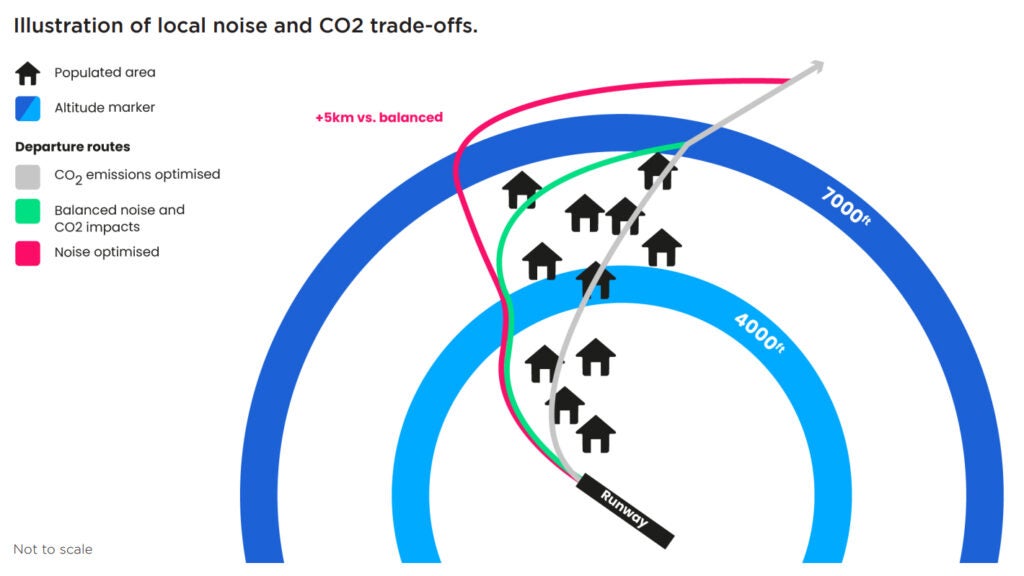
The Airspace Change Organisation Group (ACOG) published a new environment strategy on 23 September 2022, as part of the UK’s Airspace Modernisation Strategy (AMS).
The new plan sets out how changing UK airspace is helping to deliver a near-term contribution to the Government’s ‘Jet Zero’ commitments for the sector, while also reducing noise pollution where possible and freeing up regulated airspace for other airspace users.
It also provides ACOG with a platform to engage with airports and policymakers on how the industry can embed environment-led practices within aviation, which it is hoped will aid in reducing carbon emissions and noise impacts from aircraft.
ACOG was formed in 2019 as a fully independent organisation within NATS (formerly known as National Air Traffic Services), under the direction of the UK Government Department for Transport and Civil Aviation Authority (CAA).
ACOG’s mandate is to coordinate the delivery of key aspects of the UK Government’s AMS in an Airspace Masterplan, which was set out by the British Government as part of its plan for “quicker, quieter, and cleaner” flights.
The AMS involves the redesign of airspace across the UK, to make the most of the capabilities of modern aircraft and navigational technologies that have been developed in recent years.
Outdated UK airspace infrastructure
ACOG’s new strategy acknowledges that the basic structure of the UK’s airspace was designed over 50 years ago, when there were fewer aircraft in the air and tools used by air traffic controllers were much less sophisticated.
Fast forward to the current day, and high volumes of air traffic, combined with the complexity of UK airspace and the outdated route structure of much of the UK airspace network means that inefficiencies in the system are forecasted to increase over time if no action is taken.
“We are currently in the middle of a once-in-a-generation national programme of change in the way that we structure the network of airspace routes operating in our skies,” writes ACOG head Mark Swan in the forward of the new strategy.
These inefficiencies could lead to increases in cancellations or delays, and result in flights having to take more indirect routes to their destination. The consequence would be increased flight times and fuel use, and subsequently, higher carbon emissions.
ACOG puts forward the potential carbon reduction benefits of airspace modernisation as “significant”. By removing bottlenecks and lessening airborne holding (otherwise known as ‘stacks’) and introducing more direct routes, aircraft would burn less fuel – resulting in lower emissions.
This is particularly the case in congested parts of the network such as in the South-East of England, home to the two largest airports in the UK – London Heathrow and Gatwick, where ACOG says that the scope for simplification is “considerable”.

The changes are, however, something of a balancing act. Modernisation plans by NATS for airspace above 7000 feet are scheduled to reduce 2016 baseline national aviation emissions by 4.6% by 2050. At these altitudes, noise pollution is understandably a lower priority than carbon emissions.
However, at lower altitudes, the priority would be to reduce noise pollution in lieu of reducing CO2 emissions. It may not be possible to change flight routes and reduce both noise and CO2, and the report admits that a trade-off between these desired outcomes will have to be made in these cases.
UK Government policy, as per the 2017 Air Navigation Guidance is “to limit and, where possible, reduce the number of people in the UK significantly affected by adverse impacts from aircraft noise.”
Environment strategy: four key commitments
“Our environment strategy marks a significant step in creating a greener, cleaner airspace through airspace modernisation,” said Swan at the time of publication.
“For the first time in 50 years, we have the potential to change the way that we structure the network of airspace routes operating in our skies while simultaneously delivering environmental improvements. This new strategy sets out our contribution and some of the actions we are taking to make this possible.”
ACOG’s remit is to focus on coordinating the interdependent airspace changes outlined within the modernisation strategy, through an advisory role to the CAA and DfT. The new plan highlights four key commitments from ACOG in doing so:
Provision of information
The provision of information on the opportunities and challenges: ACOG will seek to be clear, accurate and informative in setting its information on environmental impacts, both forecasted and realised.
Working on the principle that “better decisions are based on better information”, ACOG will use the Masterplanning process to inform local and national stakeholders about the opportunities and challenges that exist in the programme; establishing clear environmental data in the AMS Masterplan.
Creating toolkits to evaluate the environmental impact
As this is the first time that such a significant programme of airspace change, involving multiple airports, has been undertaken in the UK, several issues are present in terms of how environmental impacts should be assessed. ACOG will collaborate with the CAA and DfT to ensure that the processes are transparent and align seamlessly with existing regulations governing the process of airspace change.
For example, ACOG will develop a cumulative assessment framework to provide guidance on how to model and assess cumulative environmental impacts and trade-offs. It will also trial the Eurocontrol IMPACT tool in partnership with Manchester Airport, to explore the model’s suitability.
Identifying and exploiting opportunities for better environmental performance
Airspace change is a complex and technically demanding undertaking that requires specialist knowledge and expertise across a number of fields. ACOG will work with airport sponsors, NATS, and the wider industry, to help share information on operational or technical changes that have the potential to deliver environmental benefits.
Engaging with stakeholders to shape the Masterplan
ACOG will maintain regular dialogue with the CAA and DfT on its activities, aligning the approach to national environmental and aviation policy. ACOG will undertake national and regional public engagement exercises as part of developing the Airspace Masterplan. It will establish stakeholder forums, including the Community Advisory Panel, to aid in creative informative materials for the public.
One Sky One Plan: ICAO alignment and new flightpaths
The strategy’s publication came ahead of the 41st International Civil Aviation Organization (ICAO) assembly, which took place between 27 September and 7 October.
The Assembly saw 193 countries, including the UK, commit to reducing international aviation emissions to net zero by 2050.
“This week, members of the International Civil Aviation Organisation agreed to a collective goal of net zero international aviation by 2050 – a historic milestone, not just for the future of flying, but for the wider international commitment to achieve net zero,” UK Transport Secretary Anne-Marie Trevelyan said following the colse of the assembly.
The ICAO also agreed to make changes to its global offsetting scheme – the Carbon Offsetting and Reduction Scheme for International Aviation. The changes aim to ensure that airlines worldwide will begin offsetting emissions from 2024.
ACOG’s Environment Strategy follows on from the launch of its One Sky, One Plan information campaign last year, which outlines how this critical national infrastructure programme will be delivered. Currently, 21 of the UK’s biggest commercial airports are involved in the airspace change programme.
According to ACOG, airspace modernisation will offer an opportunity to improve service for passengers, reduce noise pollution, and save carbon emissions.
“The modernisation programme will redefine existing flight paths – something that will directly impact communities.”
The organisation also states that changes will result in airlines having greater freedom to take routes that save time and fuel.
This is partly due to the modernisation programme redefining existing flight paths – something that will directly impact communities in and around airports, and further afield.
ACOG says that local consultations will be advertised in areas subject to changing flight paths. And that NATS and airports will hold regular community meetings during the consultation process.
While the new flightpaths could potentially have a net positive when it comes to reducing noise pollution and carbon emissions, it’s also very possible that the new paths will increase noise and carbon pollution in certain areas.



